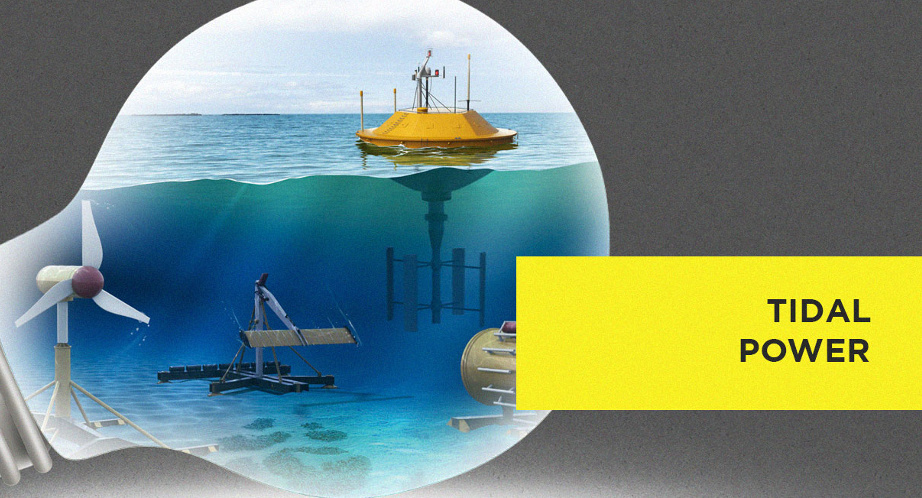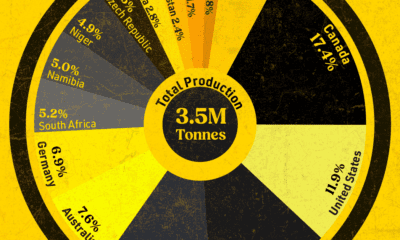Energy
The Alternative Energy Sources of the Future

Image courtesy of: Futurism
The Alternative Energy Sources of the Future
Despite the hype around the progress of renewable energy, many people don’t realize that solar and wind have only made a tiny dent in the energy mix thus far. The good news is that costs are coming down and many people are starting to adopt green technologies, but there is still a mountain to climb if we want to truly get off of fossil fuels on a large scale.
To accomplish this, we’re going to have to think outside the box to come up with new ways to tackle the energy challenge. Luckily, the folks at Futurism have put ten of the most promising alternative energy sources of the future in a handy infographic. Some of these may be long shots, but some may also play a crucial role in the energy mix of the future.
Space-based solar
Most solar energy doesn’t actually make it into the Earth’s atmosphere, so space-based solar power makes a lot of sense. The challenges are the cost in getting a satellite to orbit, as well as the conversion of electricity into microwaves that can be beamed down to the planet’s surface.
Human power
There’s over seven billion people walking around the Earth each day, so why not generate power from the movement of people? Many experts believe that we can harness this energy, and that we could use it to power our devices.
Tidal power
Five countries around the world are starting to operate viable wave power farm operations, but the potential is far higher: the U.S. coastline alone has a wave energy potential of about 252 billion KWh per year.
Hydrogen power
Hydrogen is a clean and potent source of energy, and best of all – it accounts for 74% of the mass of the entire universe. The only problem is that hydrogen atoms tend to only be found in combinations with oxygen, carbon, and nitrogen atoms. Removing this bond takes energy, which ends up being counter-productive. As a result, many people around the world are working on making these processes more economic.
Magma power
The center of the Earth is very hot, so why not try and get closer to it to tap into some geothermal heat? People in Iceland are already doing this with red-hot magma after accidentally striking a pocket of it during a 2008 drilling project.
Nuclear waste
Only 5% of uranium atoms are used in a traditional fission reaction. The rest end up in the pile of nuclear waste, which sits in storage for thousands of years. Researchers and companies are trying to tap into these leftovers for a viable and economic energy solution.
Embeddable solar power
What if every window could be easily turned into a solar panel? Solar window technology turns any window or sheet of glass into a photovoltaic solar cell that harvests the part of the light spectrum that eyes can’t see.
Algae power
Algae grows practically anywhere, and it turns out these tiny plants are a surprising source of energy-rich oils. Up to 9,000 gallons of biofuel could be “grown” per acre, making it one of many potential energy sources of the future.
Flying wind power
Winds are much more powerful and strong at higher elevations. If wind farms could be autonomous and flying, they could go to where the winds are strongest and deliver double the energy of similarly sized tower-mounted turbines.
Fusion power
Fusion has been the dream for some time – but scientists are making baby steps to achieving the power process that is harnessed in nature by our own sun. The ITER (International Thermonuclear Experimental Reactor) is currently being built in France, and it’s one of the most complex scientific and engineering projects in existence.
Energy
Charted: 4 Reasons Why Lithium Could Be the Next Gold Rush
Visual Capitalist has partnered with EnergyX to show why drops in prices and growing demand may make now the right time to invest in lithium.

4 Reasons Why You Should Invest in Lithium
Lithium’s importance in powering EVs makes it a linchpin of the clean energy transition and one of the world’s most precious minerals.
In this graphic, Visual Capitalist partnered with EnergyX to explore why now may be the time to invest in lithium.
1. Lithium Prices Have Dropped
One of the most critical aspects of evaluating an investment is ensuring that the asset’s value is higher than its price would indicate. Lithium is integral to powering EVs, and, prices have fallen fast over the last year:
| Date | LiOH·H₂O* | Li₂CO₃** |
|---|---|---|
| Feb 2023 | $76 | $71 |
| March 2023 | $71 | $61 |
| Apr 2023 | $43 | $33 |
| May 2023 | $43 | $33 |
| June 2023 | $47 | $45 |
| July 2023 | $44 | $40 |
| Aug 2023 | $35 | $35 |
| Sept 2023 | $28 | $27 |
| Oct 2023 | $24 | $23 |
| Nov 2023 | $21 | $21 |
| Dec 2023 | $17 | $16 |
| Jan 2024 | $14 | $15 |
| Feb 2024 | $13 | $14 |
Note: Monthly spot prices were taken as close to the 14th of each month as possible.
*Lithium hydroxide monohydrate MB-LI-0033
**Lithium carbonate MB-LI-0029
2. Lithium-Ion Battery Prices Are Also Falling
The drop in lithium prices is just one reason to invest in the metal. Increasing economies of scale, coupled with low commodity prices, have caused the cost of lithium-ion batteries to drop significantly as well.
In fact, BNEF reports that between 2013 and 2023, the price of a Li-ion battery dropped by 82%.
| Year | Price per KWh |
|---|---|
| 2023 | $139 |
| 2022 | $161 |
| 2021 | $150 |
| 2020 | $160 |
| 2019 | $183 |
| 2018 | $211 |
| 2017 | $258 |
| 2016 | $345 |
| 2015 | $448 |
| 2014 | $692 |
| 2013 | $780 |

3. EV Adoption is Sustainable
One of the best reasons to invest in lithium is that EVs, one of the main drivers behind the demand for lithium, have reached a price point similar to that of traditional vehicle.
According to the Kelly Blue Book, Tesla’s average transaction price dropped by 25% between 2022 and 2023, bringing it in line with many other major manufacturers and showing that EVs are a realistic transport option from a consumer price perspective.
| Manufacturer | September 2022 | September 2023 |
|---|---|---|
| BMW | $69,000 | $72,000 |
| Ford | $54,000 | $56,000 |
| Volkswagon | $54,000 | $56,000 |
| General Motors | $52,000 | $53,000 |
| Tesla | $68,000 | $51,000 |
4. Electricity Demand in Transport is Growing
As EVs become an accessible transport option, there’s an investment opportunity in lithium. But possibly the best reason to invest in lithium is that the IEA reports global demand for the electricity in transport could grow dramatically by 2030:
| Transport Type | 2022 | 2025 | 2030 |
|---|---|---|---|
| Buses 🚌 | 23,000 GWh | 50,000 GWh | 130,000 GWh |
| Cars 🚙 | 65,000 GWh | 200,000 GWh | 570,000 GWh |
| Trucks 🛻 | 4,000 GWh | 15,000 GWh | 94,000 GWh |
| Vans 🚐 | 6,000 GWh | 16,000 GWh | 72,000 GWh |
The Lithium Investment Opportunity
Lithium presents a potentially classic investment opportunity. Lithium and battery prices have dropped significantly, and recently, EVs have reached a price point similar to other vehicles. By 2030, the demand for clean energy, especially in transport, will grow dramatically.
With prices dropping and demand skyrocketing, now is the time to invest in lithium.
EnergyX is poised to exploit lithium demand with cutting-edge lithium extraction technology capable of extracting 300% more lithium than current processes.

-

 Lithium5 days ago
Lithium5 days agoRanked: The Top 10 EV Battery Manufacturers in 2023
Asia dominates this ranking of the world’s largest EV battery manufacturers in 2023.
-

 Energy1 week ago
Energy1 week agoThe World’s Biggest Nuclear Energy Producers
China has grown its nuclear capacity over the last decade, now ranking second on the list of top nuclear energy producers.
-

 Energy1 month ago
Energy1 month agoThe World’s Biggest Oil Producers in 2023
Just three countries accounted for 40% of global oil production last year.
-

 Energy1 month ago
Energy1 month agoHow Much Does the U.S. Depend on Russian Uranium?
Currently, Russia is the largest foreign supplier of nuclear power fuel to the U.S.
-

 Uranium2 months ago
Uranium2 months agoCharted: Global Uranium Reserves, by Country
We visualize the distribution of the world’s uranium reserves by country, with 3 countries accounting for more than half of total reserves.
-

 Energy3 months ago
Energy3 months agoVisualizing the Rise of the U.S. as Top Crude Oil Producer
Over the last decade, the United States has established itself as the world’s top producer of crude oil, surpassing Saudi Arabia and Russia.
-

 Science1 week ago
Science1 week agoVisualizing the Average Lifespans of Mammals
-

 Markets2 weeks ago
Markets2 weeks agoThe Top 10 States by Real GDP Growth in 2023
-

 Demographics2 weeks ago
Demographics2 weeks agoThe Smallest Gender Wage Gaps in OECD Countries
-

 United States2 weeks ago
United States2 weeks agoWhere U.S. Inflation Hit the Hardest in March 2024
-

 Green2 weeks ago
Green2 weeks agoTop Countries By Forest Growth Since 2001
-

 United States2 weeks ago
United States2 weeks agoRanked: The Largest U.S. Corporations by Number of Employees
-

 Maps2 weeks ago
Maps2 weeks agoThe Largest Earthquakes in the New York Area (1970-2024)
-

 Green2 weeks ago
Green2 weeks agoRanked: The Countries With the Most Air Pollution in 2023













